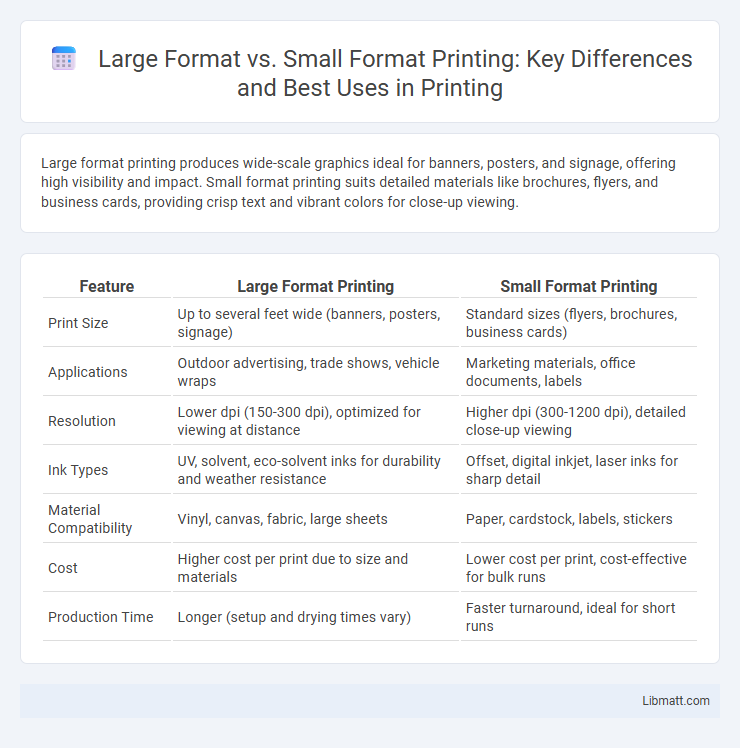Large format printing produces wide-scale graphics ideal for banners, posters, and signage, offering high visibility and impact. Small format printing suits detailed materials like brochures, flyers, and business cards, providing crisp text and vibrant colors for close-up viewing.
Table of Comparison
| Feature | Large Format Printing | Small Format Printing |
|---|---|---|
| Print Size | Up to several feet wide (banners, posters, signage) | Standard sizes (flyers, brochures, business cards) |
| Applications | Outdoor advertising, trade shows, vehicle wraps | Marketing materials, office documents, labels |
| Resolution | Lower dpi (150-300 dpi), optimized for viewing at distance | Higher dpi (300-1200 dpi), detailed close-up viewing |
| Ink Types | UV, solvent, eco-solvent inks for durability and weather resistance | Offset, digital inkjet, laser inks for sharp detail |
| Material Compatibility | Vinyl, canvas, fabric, large sheets | Paper, cardstock, labels, stickers |
| Cost | Higher cost per print due to size and materials | Lower cost per print, cost-effective for bulk runs |
| Production Time | Longer (setup and drying times vary) | Faster turnaround, ideal for short runs |
Introduction to Large Format and Small Format Printing
Large format printing produces prints typically wider than 18 inches, ideal for banners, posters, and vehicle wraps, offering high-resolution and vibrant colors on materials like vinyl and canvas. Small format printing generally covers sizes up to 18 inches, commonly used for flyers, brochures, business cards, and marketing collateral with detailed graphics on paper or cardstock. Both printing types utilize distinct technologies optimized for specific applications, balancing cost, durability, and visual impact based on project requirements.
Defining Large Format Printing
Large format printing refers to the production of prints larger than 24 inches in width, commonly used for banners, posters, and trade show graphics. It utilizes wide-format printers capable of handling media rolls up to 100 inches or more, producing high-resolution images on materials such as vinyl, fabric, and paper. This printing method supports large-scale advertising and signage by delivering vibrant colors and durability suitable for both indoor and outdoor applications.
Understanding Small Format Printing
Small format printing involves producing materials typically under 24 inches in width, such as brochures, flyers, business cards, and labels, ideal for detailed, high-resolution graphics on a smaller scale. This printing method utilizes desktop inkjet or laser printers, offering cost-effective solutions for short runs and personalized printing needs. Understanding small format printing helps you choose the right approach for precise, high-quality marketing materials and everyday office print jobs.
Key Differences Between Large and Small Format Printing
Large format printing produces prints typically over 18 inches wide, ideal for banners, posters, and vehicle wraps, using wide-format printers that accommodate large media rolls. Small format printing handles sizes smaller than 18 inches, perfect for brochures, flyers, and business cards, offering higher detail and faster turnaround on compact materials. Your choice depends on project size, resolution requirements, and display context, ensuring the best visual impact and cost-efficiency.
Common Applications for Large Format Printing
Large format printing is commonly used for outdoor advertising such as billboards, banners, and vehicle wraps due to its ability to produce high-resolution images on large surfaces. It is also essential for trade show displays, wall murals, and architectural blueprints where detailed visuals need to be scaled up without losing clarity. This printing format supports diverse materials including vinyl, fabric, and canvas, making it versatile for both commercial and artistic applications.
Typical Uses of Small Format Printing
Small format printing is commonly used for producing business cards, flyers, brochures, and promotional materials that require high detail on compact surfaces. It is ideal for marketing collateral, labels, and packaging where precise color matching and sharp imagery are essential. These prints often serve localized advertising, event handouts, and retail displays, emphasizing quality and affordability in smaller production runs.
Print Quality and Resolution Comparison
Large format printing typically offers lower resolution, around 300 dpi or less, making it ideal for banners and posters viewed from a distance, while small format printing achieves higher resolutions up to 1200 dpi, providing sharper details for close-up viewing on items like brochures and photos. The print quality in small format is enhanced by finer dot placement and advanced color management, ensuring vibrant and precise images. Your choice between large and small format printing depends on the intended viewing distance and required image clarity.
Cost Considerations: Large vs Small Format Printing
Large format printing typically involves higher costs due to specialized equipment, larger media sizes, and increased ink consumption, making it suitable for outdoor advertising, banners, and posters that require greater visibility. Small format printing offers more cost-effective solutions for items like brochures, flyers, and business cards, with lower material expenses and faster production times. Budget allocation should consider print volume, durability, and target application to optimize cost-efficiency between large and small format printing options.
Choosing the Right Format for Your Project
Large format printing excels in delivering high-impact visuals for banners, posters, and trade show displays, providing vibrant colors and crisp details on materials up to several feet wide. Small format printing suits projects requiring precision and portability, such as flyers, brochures, and business cards, offering detailed quality on smaller surfaces. Assess the viewing distance, purpose, and budget of your project to determine the most effective printing format for your needs.
Conclusion: Which Printing Format is Best for Your Needs
Large format printing excels in producing vibrant, high-impact visuals ideal for outdoor advertising, banners, and trade show displays, while small format printing is best suited for detailed, high-resolution materials like brochures, business cards, and flyers. Choosing the best printing format depends on project size, viewing distance, and budget constraints, with large format offering scalability and visibility, and small format providing sharp detail and cost-efficiency for close-range viewing. Assessing specific marketing goals and distribution methods ensures the selection of the most effective printing format to meet your needs.
large format vs small format printing Infographic

 libmatt.com
libmatt.com